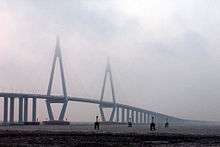Cixi City
| Cixi 慈溪市 | |
|---|---|
| County-level city | |
|
Hangzhou Bay Bridge | |
 Cixi City in Ningbo Municipality | |
 Ningbo Municipality in China | |
| Country | People's Republic of China |
| Province | Zhejiang |
| Sub-provincial city | Ningbo |
| Area | |
| • County-level city | 1,360.63 km2 (525.34 sq mi) |
| • Urban | 1,360.63 km2 (525.34 sq mi) |
| • Metro | 2,861.43 km2 (1,104.80 sq mi) |
| Population (2010 census) | |
| • County-level city | 1,462,383[1] |
| • Urban | 1,462,383 |
| • Urban density | 1,100/km2 (2,800/sq mi) |
| • Metro | 2,473,042 |
| • Metro density | 860/km2 (2,200/sq mi) |
| Time zone | China Standard (UTC+8) |
| Postal code | 315300 |
| Area code(s) | 330282 |
| Website | cixi.gov.cn |
| Cixi | |||||||||
| Chinese | 慈溪 | ||||||||
|---|---|---|---|---|---|---|---|---|---|
| Postal | Tzeki | ||||||||
| |||||||||
![]() Cixi (Chinese: 慈溪; pinyin: Cíxī; Wu: Zy去shie平) is a city within the sub-provincial city of Ningbo, Zhejiang. At the 2010 census, its population was 1,462,383 even though its built-up (or metro) area with Yuyao City had 2,473,042 inhabitants.
Cixi (Chinese: 慈溪; pinyin: Cíxī; Wu: Zy去shie平) is a city within the sub-provincial city of Ningbo, Zhejiang. At the 2010 census, its population was 1,462,383 even though its built-up (or metro) area with Yuyao City had 2,473,042 inhabitants.
History
Cixi is a city with a rich culture and a long history. It was part of the state of Yue in the Spring and Autumn period (770-476 B.C.). The county was set up in the Qin Dynasty. At first it was called “Juzhang” and has been using the name of “Cixi” since the Kaiyuan reign of the Tang Dynasty (738 A.D.).
Geography
Cixi City is located on the south of the economic circle of Yangtze River Delta, and is 60 km (37 mi) from Ningbo in the east, 148 km (92 mi) from Shanghai in the north and 138 km (86 mi) from Hangzhou in the west.
Climate
Cixi has a subtropical monsoon climate, with an average annual temperature of 16℃.
Transportation

Cixi has an effective public transportation system that provides convenience. Highway connections are provided to all major cities, typical travel times are 1.5 hours or less by car, including access to the four major airports, Ningbo Lishe International Airport, Hangzhou Xiaoshan International Airport, Shanghai Hongqiao Airport, and Shanghai Pudong International Airport. Shanghai and Ningbo are also the closest sea ports.
Economy
Cixi is an important manufacturing city in northern Zhejiang province.The Hangzhou Bay New District is located in the city.
Population
Cixi is accelerating the construction of a mid-scale modern city, covering a total land area of 1,361 km2 (525 sq mi) with a population of 2.04 million, including 1.04 million registered permanent residents and 1 million temporary residents. Fifteen towns and five subdistricts are under the jurisdiction of Cixi City and there are 325 administrative villages including committees and communities.
Culture
The city houses many Yue Kiln Sites, which are widely regarded as one of the origin of Chinese porcelain.


Cixi has the tradition of advocating culture and emphasizing education, with several thousand years of historical relics and profound cultural background which cultivated three regional cultures, i.e. “celadon, reclamation and immigration”. Shanglinhu celadon has been sold overseas as a “Maritime Silk Road” to the world, historical tideland reclamation area has become one of the areas with the most abundant land reserve resources in Zhejiang Province, and the immigration culture has several years of history.
Cixi was listed as the “demonstration base for community digital learning in the national city and countryside” by the Ministry of Education in 2010 and 2011.
Notable people
- Han Zheng - Mayor of Shanghai
 Han Zheng
Han Zheng - Tan Jiazhen - founder of modern Chinese genetics
- Ren Mei'e - President of the Chinese Geographical Society
- Lu Yongxiang - President of the Chinese Academy of Sciences
- Han Qide - Chairman of the China Association for Science and Technology
- Lu Zhangong - Secretary-in-General of Fujian Province
- Weng Wenhao - Prime Minister of the Republic of China
- Ing Chang-ki - Taiwan industrial magnate
- Zhou Xinfang - Master of Beijing Opera
- Zhu Zuxiang - agricultural scientist
- Yang Xianjiang - educationis
- Coco Zhang - Famous Chinese rapper currently in prison.
See also
References
External links
 Cixi City travel guide from Wikivoyage
Cixi City travel guide from Wikivoyage- The People's Government Cixi City official website
Coordinates: 30°10′N 121°14′E / 30.167°N 121.233°E